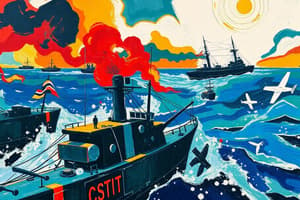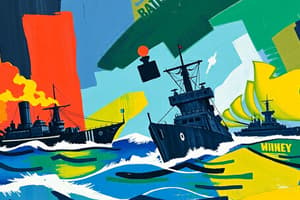Podcast
Questions and Answers
What was the primary objective of the Battle of the Atlantic?
What was the primary objective of the Battle of the Atlantic?
- To gain air superiority over the Royal Air Force
- To protect Allied merchant shipping (correct)
- To block supplies to Germany from the Allies (correct)
- To establish a new naval record
When did the Battle of the Atlantic take place?
When did the Battle of the Atlantic take place?
September 1939 to May 1945
The Battle of Britain was fought entirely by land forces.
The Battle of Britain was fought entirely by land forces.
False (B)
What was the code name for Germany's invasion of the Soviet Union?
What was the code name for Germany's invasion of the Soviet Union?
What was a significant outcome of the Battle of Britain?
What was a significant outcome of the Battle of Britain?
During which months did the Battle of Britain occur?
During which months did the Battle of Britain occur?
The Battle of the Atlantic was the longest _____ campaign in World War II.
The Battle of the Atlantic was the longest _____ campaign in World War II.
Match the following battles with their dates:
Match the following battles with their dates:
Flashcards are hidden until you start studying
Study Notes
Battle of the Atlantic (Sept 1939-May 1945)
- Longest continuous military campaign of WWII, lasting from 1939 to 1945.
- Core conflict was between Allied naval blockades of Germany and German counter-blockades.
- Peak activity occurred from mid-1940 to the end of 1943.
- Engaged U-boats and Kriegsmarine warships against Allied merchant shipping.
- Allied convoys primarily sailed from North America to the UK and USSR, protected by British, Canadian, and eventually U.S. naval forces.
- Britain required over a million tons of imported goods weekly for survival and warfare.
- The campaign was characterized as a "tonnage war," aiming to cut off supplies to Britain.
- Soviet supply buildup attempts were also thwarted by German submarine actions post-1942.
- Strategic Allied victory achieved despite heavy losses: 3,500 merchant ships and 175 warships sunk, while 783 U-boats were lost.
- Coined by Winston Churchill in February 1941, it was termed the "longest, largest, and most complex" naval battle in history.
- Over thousands of square miles of ocean featured more than 100 convoy battles and around 1,000 single-ship encounters.
- Allies innovated tactics and technology, ultimately overcoming German threats by mid-1943.
Battle of Britain (July 10-Oct 31, 1940)
- Air campaign fought entirely by Luftwaffe against the UK, marking the first of its kind in WWII.
- Aimed for air superiority over Royal Air Force (RAF), particularly Fighter Command.
- Named after Churchill's speech announcing the conflict following the fall of France.
- Main targets shifted from coastal shipping convoys to RAF airfields and aircraft production facilities.
- Terror bombing tactics were employed later in the campaign against politically significant areas.
- Germany's failure to achieve its objectives represented its first significant defeat and changed the war's momentum.
- Success for the Allies prevented Operation Sea Lion, the planned German invasion of Britain.
Operation Barbarossa (June 22, 1941-Dec 1941)
- Code name for the pivotal German invasion of the Soviet Union, commencing on June 22, 1941.
- Largest military invasion in history with over 3.9 million Axis troops involved.
- Launched along a vast front of 2,900 km (1,800 mi).
- Marked a critical turning point in the Eastern Front of WWII due to severe consequences for German military strategy.
Studying That Suits You
Use AI to generate personalized quizzes and flashcards to suit your learning preferences.




